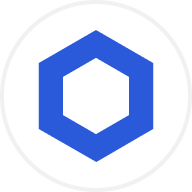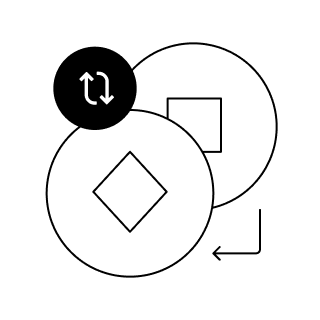What’s Chainlink (LINK)? How can I buy it?
What is Chainlink?
Chainlink is a decentralized oracle network designed to securely connect smart contracts to real-world data, off-chain computation, and traditional systems. While blockchains are excellent at creating tamper-resistant, transparent ledgers, they are intentionally isolated from external systems (“the oracle problem”). Chainlink solves this by providing a trust-minimized way for smart contracts to access reliable data feeds (such as asset prices, weather, sports results), perform verifiable off-chain computation, and interoperate across chains and with Web2 APIs.
Launched in 2017 by Sergey Nazarov and Steve Ellis, Chainlink pioneered decentralized oracles on Ethereum and has since expanded to support multi-chain ecosystems. The network’s native token, LINK, is used for node operator payments, staking, and economic security. Chainlink’s infrastructure underpins a wide range of decentralized finance (DeFi) protocols, on-chain gaming, parametric insurance, enterprise integrations, and cross-chain applications.
Notable capabilities and products in the Chainlink suite include:
- Data Feeds (Price Feeds): Aggregated, high-availability reference data (e.g., crypto asset prices) used by DeFi apps for borrowing, lending, and derivatives.
- Proof of Reserve: On-chain attestations of off-chain reserves (e.g., stablecoins, wrapped assets, RWA collateral).
- Verifiable Random Function (VRF): Cryptographically secure randomness for gaming, NFTs, and lotteries.
- Automation: Decentralized upkeep for smart contracts needing scheduled or conditional execution.
- Functions: Serverless, decentralized compute to call any API and run custom logic off-chain with cryptographic guarantees.
- Cross-Chain Interoperability Protocol (CCIP): A framework for secure, programmable cross-chain messaging and token transfers.
Chainlink is widely integrated across major chains (Ethereum, Arbitrum, Optimism, Polygon, BNB Chain, Avalanche, and more) and has seen collaboration with enterprises and financial institutions exploring tokenization and cross-chain settlement.
How does Chainlink work? The tech that powers it
At its core, Chainlink is a network of independent node operators that fetch, validate, and deliver data and computation results to smart contracts. Its architecture is designed to minimize trust in any single source or operator through decentralization, cryptographic proofs, economic incentives, and robust aggregation.
Key technical components:
- Decentralized Oracle Networks (DONs)
- Structure: For each service (e.g., ETH/USD price feed), a set of reputable nodes forms a DON. Nodes source data from premium APIs and data providers, then submit observations on-chain or to an off-chain reporting network.
- Aggregation: Observations are aggregated to produce a single reference value, using robust statistical methods (e.g., medians, outlier filtering) to mitigate manipulation and anomalies.
- Security: DONs rely on node diversity, multiple data sources, and cryptographic signatures. Many feeds employ Off-Chain Reporting (OCR) to batch and compress updates, significantly reducing gas costs while maintaining integrity.
- Off-Chain Reporting (OCR)
- Mechanism: Nodes exchange signed observations off-chain, reach consensus on the report, and submit a single on-chain transaction. This minimizes on-chain load, increases update frequency, and keeps costs predictable.
- Integrity: Reports include signatures from a quorum of nodes; smart contracts verify signatures and thresholds before accepting updates.
- Chainlink VRF (Verifiable Random Function)
- How it works: A user requests randomness; a node generates a random value and a cryptographic proof that the randomness was derived correctly from a given seed. The smart contract verifies the proof on-chain before using the value.
- Benefit: Unbiased, tamper-evident randomness, crucial for fair gaming and NFT distribution.
- Chainlink Automation
- Purpose: Allows smart contracts to be executed automatically when predefined conditions are met (e.g., rebalance, harvest, liquidate).
- Process: A decentralized network of keepers monitors conditions and triggers on-chain actions. Economic incentives and reputation systems guide honest execution.
- Chainlink Functions
- Description: A decentralized serverless compute layer that lets developers call any Web2 API and run custom JavaScript off-chain with verifiable results relayed on-chain.
- Trust model: Uses cryptographic attestations and decentralized execution to reduce reliance on single providers, enabling complex integrations (e.g., real-world identity checks, enterprise APIs).
- Proof of Reserve (PoR)
- Design: DONs fetch reserve attestations from custodians/auditors and publish on-chain proofs, enabling smart contracts to programmatically enforce collateralization requirements (e.g., pause minting if reserves fall).
- Use cases: Stablecoins, asset-backed tokens, RWAs, and cross-chain wrapped assets.
- Cross-Chain Interoperability Protocol (CCIP)
- Functionality: A generalized messaging and token transfer protocol that enables secure cross-chain dApps and tokenized asset movement.
- Security model: Employs a dual defense-in-depth design, typically involving the Risk Management Network—an independent set of nodes monitoring for anomalous activity—to mitigate cross-chain risks, which have historically been a major vector of exploits.
- Programmability: Developers can send instructions and data across chains, not just tokens, enabling complex multi-chain workflows.
- Economic security: LINK Staking and Incentives
- LINK token: Used to compensate node operators for services and to establish economic alignment.
- Staking: Node operators and community participants can stake LINK in pools associated with services (e.g., Data Feeds). Staked LINK is used for cryptoeconomic security—poor performance or malicious behavior can result in penalties, while good performance earns rewards and fees.
- Reputation and SLAs: Chainlink emphasizes performance history, signed service-level agreements, and transparent node monitoring to select reliable operators.
- Reliability engineering and decentralization
- Data source diversity: Nodes aggregate from multiple high-quality APIs/exchanges to avoid single-source failures.
- Geographic and infra diversity: Operators run in different regions/clouds with failover configurations.
- Update logic: Feeds use deviation thresholds and heartbeat intervals to publish updates when needed, balancing timeliness and gas costs.
What makes Chainlink unique?
- Battle-tested, production-grade oracles: Chainlink is the most widely adopted oracle network in DeFi, securing significant total value by providing critical price data to lending markets, DEXs, derivatives, and stablecoins. Its multi-year uptime and resilience during market volatility have contributed to a strong reputation.
- Comprehensive product suite: Beyond price feeds, Chainlink offers VRF, Automation, Functions, Proof of Reserve, and CCIP—covering data, randomness, compute, monitoring, and cross-chain messaging in one framework.
- Security-first design: OCR, node decentralization, risk management layers in CCIP, and staking-backed incentives create multiple lines of defense. Chainlink’s approach acknowledges that cross-chain and oracle layers are high-value targets and engineers accordingly.
- Enterprise and RWA focus: Collaborations and pilots involving financial institutions and market infrastructure providers reflect Chainlink’s positioning for tokenization, on-chain settlement, and interoperability between bank-grade systems and public chains.
- Chain-agnostic architecture: Chainlink’s services are integrated across leading L1s and L2s, giving developers consistent oracle tooling in multi-chain deployments.
Chainlink price history and value: A comprehensive overview
- Token overview: LINK is an ERC-677/20-compatible token used for payments to node operators, staking, and participating in the network’s cryptoeconomic security.
- Market history: Since launching in 2017, LINK experienced early growth during the 2019–2021 cycles, reaching an all-time high during the 2021 bull market. It later retraced with the broader crypto market, then saw renewed interest as Chainlink expanded services (e.g., CCIP, Functions) and institutions explored tokenization and cross-chain use cases.
- Value drivers:
- Adoption of Chainlink services (Data Feeds, CCIP, PoR, etc.) across chains and dApps.
- Growth of on-chain finance and tokenized assets that require high-integrity data and interoperability.
- Staking participation and fee generation for node services.
- Security and reliability track record relative to alternative oracle and cross-chain solutions.
- Risks and considerations:
- Competitive landscape from other oracle providers or in-protocol oracle designs.
- Smart contract/cross-chain security risks affecting oracle layers.
- Regulatory developments impacting tokenization, stablecoins, or DeFi integrations.
- Market cyclicality and liquidity conditions in crypto.
Note: Always consult up-to-date market data (price, market cap, circulating supply) from reputable sources before making decisions, as crypto markets are highly volatile.
Is now a good time to invest in Chainlink?
This depends on your risk tolerance, time horizon, and conviction in Chainlink’s role as core infrastructure for on-chain applications.
Consider the following:
- Thesis strength: If you believe decentralized oracles, cross-chain messaging, and RWA tokenization will underpin the next phase of on-chain growth, Chainlink’s position, partnerships, and product breadth could make LINK a strategic exposure.
- Fundamental traction: Evaluate active integrations (DeFi protocols using Chainlink feeds), CCIP adoption, Proof of Reserve coverage, and enterprise pilots. Higher real usage can translate into sustainable fee demand and staking dynamics.
- Token economics: Review how staking, rewards, and service fees may evolve. Understand potential supply dynamics, operator incentives, and the relationship between network usage and token value capture.
- Risk management: Diversify, size positions appropriately, and be prepared for volatility. Monitor security disclosures, audits, and incident responses. Cross-chain risks remain a key area to watch.
- Timing: Dollar-cost averaging can reduce timing risk in volatile markets. Set thesis-driven criteria (e.g., milestones in CCIP adoption or enterprise integrations) to guide entries or exits rather than relying solely on price action.
None of this is financial advice. Perform independent research, review documentation and audits, and consult a qualified financial professional if needed.
References and resources for deeper learning:
- Chainlink documentation and whitepapers (docs.chain.link)
- Chainlink blog and research updates
- Independent security audits and protocol disclosures
- On-chain analytics and DeFi dashboards for usage metrics
- Market data platforms for up-to-date pricing and token metrics
Discover the different ways to buy crypto
Create an OKX account
Get verified
Start a trade
Enter an amount
Choose your payment method
Confirm your order
All done
Create an OKX account
Get verified
Start a trade
If Chainlink isn’t available in the dropdown, purchase any of the available tokens and convert it to LINK.
Place a buy order
Complete your purchase
Receive your LINK
All done
Get the OKX app or Wallet extension
Set up your wallet
Fund your wallet
Find your next purchase
Note:
Tokens with the same symbol can exist on multiple networks or may be forged. Always double-check the contract address and blockchain to avoid interacting with the wrong tokens.
Trade your crypto on OKX DEX
Choose the token you’re paying with (e.g., USDT, ETH, or BNB), enter your desired trading amount, and adjust slippage if needed. Then, confirm and authorize the transaction in your OKX Wallet.
Limit order (optional):
If you’d prefer to set a specific price for your crypto, you can place a limit order in Swap mode.
Enter the limit price and trading amount, then place your order.
Receive your crypto
All done
Learn more about how to buy Chainlink (LINK)


Make informed decisions


How to get Chainlink for free
See what you can do with your crypto
How to buy Chainlink (LINK) FAQ
Disclaimer
You are viewing content that has been summarized by AI. Please be aware that the information provided may not be accurate, complete, or up-to-date. This information is not (i) investment advice or an investment recommendation, (ii) an offer, solicitation, or inducement to buy, sell or hold digital assets, or (iii) financial, accounting, legal or tax advice. Digital assets are subject to market volatility, involve a high degree of risk, and can lose value. You should carefully consider whether trading or holding digital assets is suitable for you in light of your financial condition and risk tolerance. Please consult your legal/tax/investment professional for questions about your specific circumstances.














